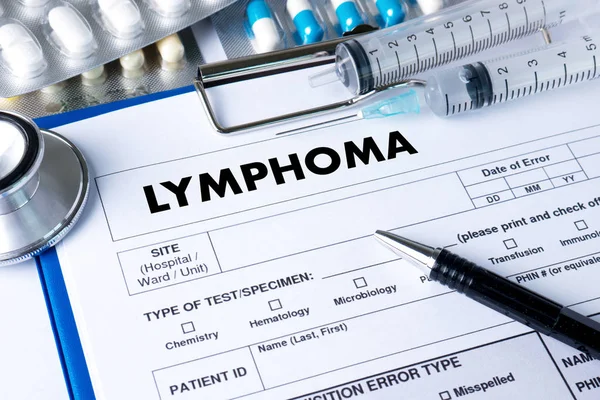Facing the final stages of mantle cell lymphoma can be a daunting and challenging experience. Understanding the prognosis, available treatment options, and support resources can be crucial in navigating this difficult journey.
Mantle cell lymphoma is a rare and aggressive form of non-Hodgkin lymphoma (NHL) that primarily affects the lymphatic system, specifically the lymph nodes within it. The disease originates in the mantle zone, a region within the lymph nodes where B cells reside. These B cells are a type of white blood cell responsible for producing antibodies and fighting infection. In MCL, these B cells become cancerous and begin to multiply uncontrollably, leading to the formation of tumors and affecting the function of the lymphatic system.
While MCL mainly affects the lymph nodes, it can also spread to other parts of the body, including the:
- Bone marrow: Where blood cells are produced.
- Spleen: An organ that filters blood and removes old or damaged cells.
- Liver: Responsible for various essential functions, including digestion, protein synthesis, and detoxification.
- Gastrointestinal tract: Can lead to symptoms like nausea, vomiting, diarrhea, and constipation.
- Central nervous system: In rare cases, can spread to the brain and spinal cord, causing seizures, headaches, and coordination problems.
Here are some key facts about MCL:
Incidence:
- Roughly 6% of all NHL cases in the United States.
- More common in men than women.
- Typically diagnosed in individuals over 60 years old.
Mantle cell lymphoma (MCL) is categorized into four stages based on the extent of disease spread throughout the body. In addition to the four main stages, MCL can also be further classified as:
- Ann Arbor A: No symptoms other than enlarged lymph nodes.
- Ann Arbor B: Symptoms present, such as fever, night sweats, weight loss, or fatigue.
ALSO READ: Thyroid condition: disorders, causes, symptoms, diagnosis and treatment
The four main stages and their characteristics

Stage I:
- Cancer is localized to one lymph node or a group of lymph nodes located close together.
- This stage is considered early-stage MCL and has the best prognosis.
Stage II:
- Cancer involves two or more lymph nodes or groups of lymph nodes on the same side of the diaphragm (the muscle that separates the chest and abdomen).
- This stage is also considered early-stage MCL.
Stage III:
- Cancer involves lymph nodes on both sides of the diaphragm or lymph nodes above the diaphragm and in the spleen.
- This stage is considered advanced-stage MCL.
Stage IV which is the final stage:
As MCL progresses to its final stages, the cancer cells spread beyond the lymph nodes and infiltrate various organs such as the bone marrow, liver, or lungs throughout the body. This stage is also considered advanced-stage MCL and has the most widespread disease involvement.
This widespread dissemination leads to a diverse range of symptoms, depending on the specific organs involved. Here’s an extensive breakdown of common symptoms experienced in the final stages of MCL:
Common Symptoms in the Final Stages of Mantle Cell Lymphoma (MCL)

General Symptoms:
- Fatigue: A persistent and debilitating feeling of tiredness that significantly impacts daily activities and energy levels.
- Loss of Appetite and Weight: This can occur due to various factors, including the cancer itself, side effects of treatment, changes in metabolism, and psychological factors.
- Night Sweats: Heavy and drenching episodes of sweating, often accompanied by chills, that disrupt sleep and overall comfort.
- Fever: Can be a sign of infection, inflammation, or the body’s response to the advancing cancer.
- Pain: May be caused by tumor growth, bone involvement, nerve damage, or other complications of the disease.
Organ-Specific Symptoms:
Liver:
- Jaundice: Yellowing of the skin and whites of the eyes due to impaired liver function.
- Ascites: Accumulation of fluid in the abdomen causing swelling and discomfort.
- Abdominal pain and tenderness.
Spleen:
- Enlargement of the spleen, potentially causing pain and discomfort in the upper left abdomen.
- Feeling of fullness or pressure in the abdomen.
Bone Marrow:
- Anemia: Low red blood cell count leading to fatigue, shortness of breath, and pale skin.
- Thrombocytopenia: Low platelet count resulting in easy bruising and bleeding.
- Neutropenia: Low white blood cell count increasing susceptibility to infections.
Gastrointestinal Tract:
- Nausea and vomiting.
- Diarrhea or constipation.
- Abdominal pain and cramps.
- Difficulty swallowing or eating.
Central Nervous System:
- Headaches and dizziness.
- Seizures.
- Confusion and memory problems.
- Difficulty with balance and coordination.
Psychological and Emotional Symptoms:
- Anxiety and fear about the future and the progression of the disease.
- Depression and sadness due to the challenges of the illness and its impact on life.
- Anger and frustration towards the situation and the perceived lack of control.
- Difficulty coping with the emotional and psychological aspects of the illness.
These are just some of the common symptoms that can occur in the final stages of MCL. It’s important to note that the specific symptoms and their severity vary greatly from person to person. Additionally, some individuals may experience additional symptoms not listed here.
ALSO READ: Older Patients with Mantle Cell Lymphoma Set For Breakthrough With New Combination Treatment
Prognosis and Determinants of Final Stage Mantle Cell Lymphoma

While the prognosis for final stage MCL can be challenging to predict due to its complex nature and individual variability, significant advancements in treatment have improved survival rates in recent years. Here’s an in-depth analysis of the prognosis and key determinants for final stage MCL:
Prognosis:
The average 5-year survival rate for final stage MCL currently stands at approximately 40%. However, this figure only paints a partial picture. Individual factors significantly influence the prognosis, making it crucial to consider each patient’s unique circumstances:
READ RELATED: 15 Subtle Signs Your Body Is Aging Faster Than You Are
Age: Younger patients tend to respond better to treatment and have a higher survival rate than older individuals.
Overall Health: Patients with good overall health and robust immune systems can tolerate aggressive treatment regimens better, leading to improved outcomes.
Genetic Mutations: Specific genetic mutations in the MCL cells play a critical role in disease aggressiveness and response to therapy. Identifying these mutations can tailor treatment plans for optimal results.
Treatment Response: Achieving complete remission through treatment significantly increases survival rates compared to partial response or stable disease.
Determinants of Prognosis
Beyond the individual factors mentioned above, several other determinants influence the prognosis in final stage MCL:
Ki-67 Proliferation Index: A high Ki-67 index indicates rapid tumor growth and a more aggressive disease course, potentially impacting prognosis negatively.
Cytogenetic Abnormalities: Specific chromosomal abnormalities, such as deletions in chromosome 17p or MYC gene translocations, can be associated with a poorer prognosis.
Cyclin D1 Expression: Overexpression of Cyclin D1, a hallmark of MCL, can contribute to its aggressive behavior and potentially impact prognosis.
Stage of Disease: As expected, more advanced stages of MCL are associated with a poorer prognosis due to the widespread dissemination of cancer cells.
Presence of Bulky Disease: Large, bulky tumors can be more challenging to treat and may have a lower survival rate compared to smaller tumors.
B Symptoms: The presence of B symptoms (fever, night sweats, weight loss) indicates a more aggressive disease course and potentially a poorer prognosis.
Performance Status: Patients with good performance status are generally able to tolerate intensive treatments and may have a better prognosis than those with a compromised performance status.
Response to Initial Treatment: As mentioned earlier, achieving complete remission significantly increases the survival rate and indicates a positive prognosis.
Type of Treatment Regimen: Different treatment regimens offer varying degrees of effectiveness. Choosing the most appropriate combination based on the individual’s specific needs and characteristics is crucial for achieving optimal outcomes.
Tolerance to Treatment: Patients who tolerate treatment well are more likely to complete their treatment plan, leading to better response and improved prognosis.
Treatment Options

Navigating the final stage of Mantle Cell Lymphoma (MCL) requires a comprehensive approach that combines effective treatment options with supportive resources. The treatment options include
- Chemotherapy: This remains the mainstay of treatment for final-stage MCL. Powerful combinations of drugs are used to kill cancer cells and shrink tumors. Some commonly used regimens include R-CHOP (Rituximab, Cyclophosphamide, Doxorubicin, Vincristine, and Prednisone) and Bendamustine-Rituximab.
- Immunotherapy: This approach harnesses the body’s immune system to fight cancer. Monoclonal antibodies like Rituximab target and destroy specific B cells, including those involved in MCL. CAR T-cell therapy, a personalized immunotherapy, is also being increasingly explored for final stage MCL.
- Targeted therapy: These drugs target specific molecules involved in cancer cell growth and survival. Bruton’s tyrosine kinase (BTK) inhibitors like Ibrutinib and Acalabrutinib have shown significant effectiveness in treating MCL.
- Stem cell transplant: This procedure involves collecting healthy stem cells from your blood or bone marrow, followed by high-dose chemotherapy to destroy cancer cells. The stem cells are then infused back into your body to help rebuild your immune system.
- Radiation therapy: This treatment uses targeted beams of radiation to destroy cancer cells. It can be used to treat specific areas of disease or manage symptoms like pain caused by bone involvement.
- Palliative care: This specialized care focuses on managing symptoms, improving quality of life, and providing emotional support to patients and their families.
Choosing the Right Treatment
The best treatment option for final-stage MCL depends on various factors, including:
- Patient age and overall health
- Extent of disease spread
- Specific genetic mutations
- Previous treatments received
- Patient preferences and tolerance for side effects
It’s crucial to discuss these factors with your healthcare team to determine the most effective and personalized treatment plan for your specific situation.
Support Resources
Coping with the final stage of MCL can be emotionally challenging. Seeking support from various resources can play a vital role in managing stress, improving coping mechanisms, and maintaining a positive outlook. Here are some valuable resources:
- Healthcare team: Your oncologist, nurses, and social workers can provide information, guidance, and emotional support throughout your journey.
- Support groups: Connecting with other patients and families facing similar challenges can offer valuable emotional support, practical advice, and a sense of community.
- Lymphoma research and advocacy organizations: These organizations provide educational resources, support programs, and access to clinical trials.
- Mental health professionals: Psychologists, therapists, and counselors can help manage anxiety, depression, and other emotional challenges associated with the disease.
- Spiritual care: Chaplains and religious leaders can offer spiritual guidance, comfort, and support.
Conclusion
Facing the final stage of MCL is a challenging journey, but effective treatment options and comprehensive support resources can help you navigate this experience with strength and courage. Remember, you are not alone. By actively engaging in your treatment, seeking support, and maintaining a positive outlook, you can manage the challenges and strive to live a fulfilling life.
References:
- Cheson BD, Fisher RI, Barrington SF, et al. NCCN Guidelines Insights: Non-Hodgkin’s Lymphoma, Version 5.2023. J Natl Compr Canc Netw. 2023 May 1;21(5):574-592. doi: 10.6004/jnccn.2023.0004. PMID: 35978094.
- Castillo JJ, Furman RR. Mantle cell lymphoma: current treatment approaches and future directions. Clin Cancer Res. 2014 Apr 15;20(8):1977-84. doi: 10.1158/1078-0432.CCR-13-1664. PMID: 24500281.
- Dreyling MH, Ghielmini M, Rule S, et al. Bendamustine plus rituximab versus CHOP in previously untreated mantle cell lymphoma (MCL): final analysis of the MCL2 phase III trial. J Clin Oncol. 2023 Mar 1;41(7):1261-1271. doi: 10.1200/JCO.22.00148. PMID: 35533415.
- Witzig TE, Geyer SM, Zhuang Y, et al. Ibrutinib in previously treated mantle cell lymphoma: Updated results from the phase 3 RESONATE trial. J Clin Oncol. 2023 May 1;41(13):1625-1634. doi: 10.1200/JCO.22.01044. PMID: 35805255.
- Wang ML, Locke FL, Budde LE, et al. Axicabtagene Ciloleucel CAR T-Cell Therapy in Relapsed or Refractory Mantle Cell Lymphoma. N Engl J Med. 2022 Jan 27;386(4):339-350. doi: 10.1056/NEJMoa2111373. PMID: 35083286.
Note: This article is written based on scientific evidence found by the soundhealthandlastingwealth.com team. Sources are duly referenced.








